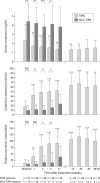Long term outcome after transjugular intrahepatic portosystemic stent-shunt in non-transplant cirrhotics with hepatorenal syndrome: a phase II study
- PMID: 10896924
- PMCID: PMC1727992
- DOI: 10.1136/gut.47.2.288
Long term outcome after transjugular intrahepatic portosystemic stent-shunt in non-transplant cirrhotics with hepatorenal syndrome: a phase II study
Abstract
Background: Recent small studies on hepatorenal syndrome (HRS) indicate some clinical benefit after transjugular intrahepatic portosystemic stent-shunt (TIPS) but sufficient long term data are lacking.
Aim: We studied prospectively feasibility, safety, and long term survival after TIPS in 41 non-transplantable cirrhotics with HRS (phase II study).
Patients and methods: HRS was diagnosed using current criteria (severe (type I) HRS, n=21; moderate (type II) HRS, n=20). Thirty one patients (14 type I, 17 type II) received TIPS (8-10 mm) while advanced liver failure excluded shunting in 10. During follow up (median 24 months) we analysed renal function and survival (Kaplan-Meier).
Results: TIPS markedly reduced the portal pressure gradient (21 (5) to 13 (4) mm Hg (mean (SD)); p<0.001) with one procedure related death (3.2%). Renal function deteriorated without TIPS but improved (p<0.001) within two weeks after TIPS (creatinine clearance 18 (15) to 48 (42) ml/min; sodium excretion 9 (16) to 77 (78) mmol/24 hours) and stabilised thereafter. Following TIPS, three, six, 12, and 18 month survival rates were 81%, 71%, 48%, and 35%, respectively. As only 10% of non-shunted patients survived three months, total survival rates were 63%, 56%, 39%, and 29%, respectively. Multivariate Cox regression analysis revealed bilirubin (p<0.001) and HRS type (p<0.05) as independent survival predictors after TIPS.
Conclusions: TIPS provides long term renal function and probably survival benefits in the majority of non-transplantable cirrhotics with HRS. These data warrant controlled trials evaluating TIPS in the management of HRS.
Figures


Comment in
-
Improving prognosis in hepatorenal syndrome.Gut. 2000 Aug;47(2):166-7. doi: 10.1136/gut.47.2.166. Gut. 2000. PMID: 10896904 Free PMC article. No abstract available.
References
Publication types
MeSH terms
LinkOut - more resources
Full Text Sources
Medical
Research Materials
